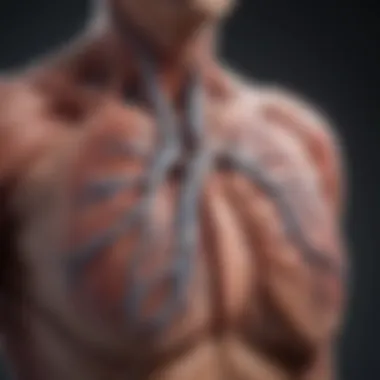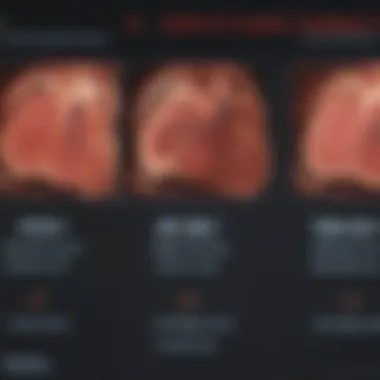Understanding PVR Cardiac Test: An In-Depth Exploration


Intro
The PVR cardiac test plays a crucial role in evaluating cardiac function, specifically focusing on pulmonary vascular resistance. This test helps clinicians understand how well the heart is working, particularly in patients with suspected heart or lung conditions. Gaining insight into the dynamics of pulmonary circulation is essential for diagnosing and managing a range of cardiovascular diseases. This article aims to present comprehensive details about the PVR cardiac test, discussing its significance, methodology, and interpretation while also addressing the latest advancements in this area.
Research Overview
Summary of Key Findings
The PVR cardiac test has emerged as a significant tool in cardiology. Understanding how to assess pulmonary vascular resistance provides vital information for diagnosing various cardiac and pulmonary conditions. Research indicates that higher pulmonary vascular resistance can be associated with heart failure, pulmonary hypertension, and other significant cardiovascular disorders. Evaluating this parameter often leads to better patient management and treatment options.
Importance of the Research in Its Respective Field
The relevance of PVR measurements extends beyond mere diagnostics. Clinicians utilize these findings to make informed decisions regarding therapeutic interventions. Recent advancements in imaging and data collection enhance the test's reliability, thereby improving patient outcomes. Research on PVR also informs ongoing studies into the underlying mechanisms of pulmonary diseases and their impact on overall cardiac performance.
Methodology
Description of the Experimental or Analytical Methods Used
The PVR cardiac test typically involves measuring pressures in the pulmonary arteries and the left atrium during cardiac catheterization. A specialized catheter is navigated through the vascular system to acquire pressure readings, usually under fluoroscopy guidance. Data obtained helps calculate pulmonary vascular resistance using the equation:
PVR = (Mean Pulmonary Artery Pressure - Pulmonary Capillary Wedge Pressure) / Cardiac Output.
This standard methodology helps ensure consistency and reliability in results.
Sampling Criteria and Data Collection Techniques
Patient selection is critical for obtaining meaningful results from the PVR test. Individuals with known cardiovascular anomalies, such as heart failure, should have priority, along with those exhibiting symptoms suggesting pulmonary issues. During data collection, it is essential to ensure a controlled environment; factors such as medication, body position, and recent physical activity can influence results. Clinicians need accurate data to interpret the numbers effectively and customize treatment to best address patient needs.
"Understanding the underlying physiological principles of PVR testing is essential for accurate interpretation and effective patient care."
Evaluating the PVR cardiac test can enhance diagnostic accuracy in complex clinical scenarios affecting cardiac and pulmonary health. As research advances, its methodology will likely continue to evolve, offering further insights into the intricate relationships between heart function and pulmonary resistance.
Prologue to PVR Cardiac Test
The PVR cardiac test is a pivotal tool in the realm of cardiology, significantly enhancing our ability to assess cardiac function and understand underlying pulmonary hemodynamics. By measuring pulmonary vascular resistance, clinicians can derive insights that inform both diagnosis and treatment pathways for various cardiovascular conditions. This introduction aims to underscore the importance of the PVR cardiac test, detailing specific elements, benefits, and considerations for medical professionals and researchers alike.
Definition of PVR
Pulmonary Vascular Resistance (PVR) is expressed as the resistance the pulmonary vasculature offers to blood flow. It is calculated using the formula:
This calculation provides an indication of the workload imposed on the right side of the heart and the condition of the pulmonary circulation. Elevated PVR can indicate pathological processes affecting heart and lung function.
Importance in Cardiology
The significance of the PVR cardiac test in cardiology cannot be overstated. High PVR can indicate serious conditions such as pulmonary hypertension or heart failure. Here are some crucial points regarding its importance:
- Diagnostic Utility: PVR helps in diagnosing various cardiac conditions, enabling timely and appropriate management of diseases that can lead to significant morbidity and mortality.
- Management of Patients: Understanding PVR values assists healthcare providers in selecting treatment strategies, optimizing medications, and determining the need for surgical interventions.
- Monitoring Disease Progression: Regular assessment of PVR can yield valuable insights into the progression of cardiac diseases, guiding clinical decisions and improving patient outcomes.
- Research Applications: In research, PVR measurements play a critical role in exploring new treatments and understanding the pathophysiology of cardiovascular diseases.
PVR testing thereby serves as a fundamental assessment in modern cardiology, helping bridge the gap between clinical findings and actionable treatment strategies.
Physiological Principles of PVR
The physiological principles underlying the Pulmonary Vascular Resistance (PVR) cardiac test are crucial for understanding its relevance in cardiology. PVR serves as an indicator of how well the heart pumps blood through the pulmonary circuit and how effectively the pulmonary vessels respond. Adequate knowledge of these principles allows healthcare professionals to interpret results meaningfully and aids in making informed clinical decisions.
Understanding Cardiac Output
Cardiac output is a key concept in the study of PVR and reflects the volume of blood the heart pumps per minute. It is determined by two factors: stroke volume and heart rate. Stroke volume is the amount of blood ejected from the left ventricle with each heartbeat, while heart rate is the number of times the heart beats in one minute. A normal cardiac output indicates the heart's efficiency in delivering oxygen-rich blood to the body's organs.
In evaluating PVR, understanding cardiac output becomes imperative. If the heart cannot maintain an appropriate output, it may lead to heightened resistance in the pulmonary arteries, which can signal underlying conditions such as heart failure or pulmonary hypertension. The relationship between cardiac output and PVR reflects the complex interplay of heart function and vascular resistance, ultimately affecting patient management strategies.
Role of Pulmonary Circulation
The role of pulmonary circulation in the context of PVR is equally significant. This system refers to the passage of blood from the right ventricle of the heart through the lungs and back to the left atrium. The primary function of pulmonary circulation is to facilitate gas exchange, allowing for oxygen uptake and carbon dioxide removal.


When analyzing the PVR cardiac test, understanding how the pulmonary circuit affects resistance is vital. High resistance in pulmonary vessels can indicate obstruction or increased pressure within the lungs. Such conditions can lead to a cascade of clinical consequences, including decreased oxygenation and compromised cardiac output.
The importance of pulmonary circulation must not be underestimated. It significantly influences overall cardiovascular health and is crucial in diagnosing various pulmonary and cardiac conditions.
In summary, the physiological principles of PVR, including cardiac output and the role of pulmonary circulation, help frame the context for clinical assessments and interventions. Recognizing these principles enriches the understanding of PVR and ultimately enhances patient management.
Methodology of PVR Cardiac Testing
The methodology of PVR cardiac testing serves as the backbone of how healthcare professionals assess the pulmonary vascular resistance in patients. This method not only helps to establish a clearer picture of cardiac function but also plays a critical role in diagnosing various cardiac conditions. Understanding the elements involved in the methodology contributes significantly to the accuracy and effectiveness of the results.
Preparation for the Test
Preparing for the PVR test is a crucial step in ensuring the reliability of the results. The preparation involves multiple aspects, including informing the patient about the test, fasting, and ensuring the appropriate medication regimen.
Patients are often required to refrain from certain medications that can affect hemodynamics, such as diuretics, prior to the test. Additionally, they may need to fast for a specific period. Clear communication by the healthcare provider is essential to eliminate any confusion and facilitate compliance.
Moreover, pre-testing screening such as laboratory tests may be needed to rule out concurrent conditions that could influence the PVR measurement. A well-prepared patient is likely to enhance the validity of the PVR test results.
Conducting the Test
Conducting the PVR test involves several critical steps that ensure the assessment is thorough and accurate. Two primary components of this process are intravenous access and measurement techniques.
Intravenous Access
Intravenous access is a fundamental part of the PVR testing procedure. It allows direct measurement of pressures within the heart and pulmonary arteries. This method is preferred because it provides real-time data as opposed to indirect measurement methods. Without proper intravenous access, obtaining accurate readings would be difficult.
One key characteristic of intravenous access is the ability to inject contrast agents or medications during the test, which can further aid in accurately gauging cardiac performance. This feature makes it a beneficial choice in this context.
However, the procedure carries specific risks, such as infection or discomfort at the site of insertion. Nonetheless, the advantages often outweigh the disadvantages, especially when accurate data on pulmonary hemodynamics is a priority.
Measurement Techniques
Measurement techniques in PVR testing refer to the various methods employed to gauge pulmonary vascular resistance accurately. These techniques can include catheterization, and non-invasive methods like echocardiography and MRI, depending on the clinical scenario.
One notable characteristic is the precision of catheterization for measuring pressures. It remains a gold standard in many situations as it provides detailed insights into cardiac function. However, it is considered invasive and can cause complications, which is a drawback that must be weighed against its benefits.
Emerging non-invasive techniques are gaining popularity as they reduce patient discomfort and complications. Nevertheless, they may not yet match the detail provided by catheterization. Hence, both techniques have their unique features and should be selected based on the specific clinical requirements and patient conditions.
In summary, the methodology of PVR testing, encompassing preparation, intravenous access, and measurement techniques, is crucial for accurate diagnoses in cardiac evaluations. This careful structuring ensures clinical efficacy and enhances overall patient outcomes.
Interpreting PVR Results
Interpreting the results of a PVR cardiac test is critical in the field of cardiology. It provides insights that can guide treatment decisions and help in the management of various cardiovascular conditions. Understanding PVR helps physicians assess the efficiency of blood flow through the pulmonary circuit, which has important implications for patient health. A deeper understanding of PVR results also allows for more personalized treatment regimens, thereby improving patient outcomes.
Normal Values and Ranges
To effectively interpret PVR results, it is essential to know the normal values and ranges. Typically, normal PVR values are considered to be between 1.5 and 3.0 Wood units. Values above this range may indicate potential issues. It’s important to take into account other patient factors, including age, sex, and overall health, to accurately assess these numbers. Doing so enables healthcare professionals to differentiate between normal physiological variations and significant pathologies.
The PVR value serves as a window into the hemodynamic status of the patient, offering clues about both cardiac and pulmonary health.
Clinical Implications of Elevated PVR
Elevated PVR can be indicative of multiple clinical conditions. The implications are often far-reaching and necessitate careful investigation. Two common conditions associated with high PVR are congenital heart disease and pulmonary hypertension.
Congenital Heart Disease
Congenital heart defects often lead to altered blood flow patterns, contributing to elevated PVR. These defects can cause structural abnormalities in the heart that affect how blood is pumped. In patients with congenital heart disease, the increased resistance can exert strain on the heart, leading to complications such as right heart failure if left untreated. Monitoring PVR can thus be crucial for patient management, since it provides measurable data that helps determine treatment urgency.
The key characteristic of congenital heart disease is its diversity; it encompasses various abnormalities. Each type may affect pulmonary resistance differently, making it important for healthcare professionals to tailor interventions based on specific defects and their related PVR levels.


Pulmonary Hypertension
Pulmonary hypertension is another critical area of concern related to elevated PVR. This condition results from increased pressure in the pulmonary arteries, which can lead to severe complications including right ventricular failure. Elevated PVR serves as one of the key diagnostic criteria for pulmonary hypertension, allowing for timely intervention.
The key characteristic here is the measurable impact of increased resistance on the heart's ability to pump blood effectively. Pulmonary hypertension can arise from various causes, ranging from chronic lung diseases to thromboembolic events, making its identification wildly beneficial in the clinical setting. High PVR readings, therefore, could lead to further diagnostic evaluation and subsequent management decisions tailored to the individual patient.
Understanding these conditions emphasizes the significance of PVR not just as a standalone measurement, but as an integral component of a broader diagnostic puzzle. Misinterpretation or overlooking elevated PVR can delay critical treatment steps and worsen patient prognosis.
Considerations for Specific Populations
The PVR cardiac test holds significant relevance across various demographic groups. Understanding its application in specific populations is critical. Each population, particularly pediatrics and geriatrics, showcases unique physiological characteristics and risk factors that influence how cardiac health is assessed and managed. Tailoring the PVR test approaches based on these characteristics is essential for accurate diagnostics and optimal patient outcomes.
Pediatric Considerations
Pediatric patients present distinct challenges in cardiovascular assessments, necessitating a tailored approach to PVR testing. Their developing bodies exhibit different responses compared to adults. Infants and children may have elevated heart rates and varying pulmonary resistance levels, making standard adult parameters less applicable.
Benefits of PVR Testing in Pediatrics:
- Early Detection: Identifying pulmonary vascular resistance early can lead to timely interventions, particularly for congenital heart diseases.
- Monitoring Growth: Regular assessments help in observing the impact of growth on cardiovascular function.
Considerations to Keep in Mind:
- Age-Appropriate Calibration: Adjusting measurements to account for age and size is vital.
- Anxiety Management: Utilizing child-friendly methodologies to ease the testing process is important, as anxiety can affect results.
Geriatric Considerations
The geriatric population presents its own set of complexities in cardiovascular assessment, as age-related physiological changes can influence PVR test results. Increased vascular stiffness and altered hemodynamics are common in older adults.
Importance of PVR Testing in Geriatrics:
- Risk Stratification: Understanding the level of pulmonary vascular resistance helps in stratifying risks for heart failure and other age-related cardiovascular conditions.
- Personalized Treatment Plans: Insight into PVR allows healthcare providers to better tailor therapeutic strategies based on individual patient profiles.
Key Considerations for Geriatric Patients:
- Comorbidities: Many seniors present with multiple health conditions, which may affect PVR readings.
- Cognitive Function: It is essential to consider cognitive impairments that may impact a patient’s ability to follow instructions during the testing process.
Advancements in PVR Testing Techniques
Advancements in PVR testing techniques play a significant role in enhancing the reliability and accuracy of assessments in cardiovascular health. As technology evolves, new methodologies emerge, providing cardiologists with better tools to evaluate pulmonary vascular resistance. These advancements are crucial as they improve patient outcomes and streamline clinical practice.
Innovations in Measurement Technology
Measurement technology in PVR assessment has seen several innovations. Traditional methods often relied on invasive techniques, which could present risks of complications for the patient. New measurement devices now offer non-invasive options that allow for accurate readings without the need for catheterization. Techniques such as echocardiography have been refined, providing real-time imaging of cardiac function and pulmonary pressures. This innovation allows for quicker evaluations and a better patient experience, as less invasive options reduce recovery times and complications.
Fast, accurate, and reliable measurement technologies ensure that clinicians can make informed decisions swiftly. Additionally, these technologies contribute to a more comprehensive understanding of a patient's pulmonary hemodynamics, critical for managing various cardiac conditions.
Emerging Research Areas
Non-Invasive Methods
Non-invasive methods in PVR testing are increasingly popular due to their ability to provide safe and accurate assessments. These techniques eliminate the risks associated with invasive procedures, such as infection or bleeding, making them a vital choice for patient evaluation.
One key characteristic of non-invasive methods is their ability to gather significant data without discomfort to the patient. Techniques like cardiac MRI and advanced echocardiography allow clinicians to evaluate the heart's function and blood flow. This capability makes them beneficial in monitoring chronic conditions where frequent assessments are necessary.
The unique feature of non-invasive methods is the ease of use and convenience for both patients and healthcare providers. They can be performed outpatient without the need for extensive preparation or recovery. However, it is essential to note that these methods may have limitations in measuring certain parameters with the same precision as invasive techniques.
Longitudinal Studies
Longitudinal studies in the context of PVR testing provide valuable insights into how pulmonary vascular resistance changes over time. By following patients and collecting data over extended periods, researchers can assess the progression of conditions like pulmonary hypertension.


A key characteristic of these studies is their capacity to observe trends and make connections between PVR and other cardiovascular factors. They allow for a comprehensive understanding of how interventions affect patient outcomes over time. This aspect makes longitudinal studies a beneficial approach in the ongoing research of pulmonary vascular health.
The unique feature of longitudinal studies is their emphasis on long-term data collection. This can lead to better disease management strategies, as patterns emerge that inform clinical practice. One possible disadvantage is the time and resources required to conduct these studies, but the information they provide can be invaluable in advancing the field of cardiology.
Potential Complications and Risks
The PVR cardiac test, while crucial for assessing pulmonary vascular resistance, is not without its potential complications and risks. Understanding these issues is essential for both practitioners and patients alike. Addressing the risks associated with this test can improve patient safety and enhance the overall diagnostic process. Thus, it is vital to consider the implications and preventive actions related to the PVR cardiac test.
Understanding the Risks
Like any medical procedure, the PVR cardiac test carries certain risks. Some patients may experience discomfort during the test. This is often due to the intravenous access required for the procedure. Additionally, there could be adverse reactions to contrast agents used in some testing methodologies. Allergic reactions, though rare, may occur. Patients with pre-existing conditions such as chronic kidney disease must be closely monitored, as the contrast can exacerbate their condition.
Another risk is the potential for infection at the site of intravenous access. This is particularly concerning in patients with compromised immune systems. There may also be a risk of bleeding if blood vessels are punctured incorrectly during the procedure. Moreover, patients with known heart conditions may face complications related to changes in hemodynamic status.
"Consider all potential risks before undergoing any cardiac test. Patient safety should always come first."
Mitigating Complications
To address these risks, a thorough assessment before conducting the PVR cardiac test is essential. Medical professionals should evaluate patient history thoroughly, focusing on allergies and any previous adverse reactions to similar tests.
Following measures can help mitigate complications:
- Patient Education: Educate patients on what to expect during the test. Understanding the process can reduce anxiety and improve cooperation.
- Skillful Administration: Ensuring that only experienced staff conduct the test can reduce the likelihood of complications. Proper training in vein selection and insertion techniques is critical.
- Hygiene Protocols: Adhering to strict hygiene protocols can minimize the risk of infection. Using sterile instruments and maintaining a clean area for the procedure is vital.
- Monitoring Post-Test: Continuous observation after the test helps in identifying any immediate complications. Timely intervention is crucial should any issues arise.
Safeguarding our patients is a priority during any diagnostic procedure. By understanding risks and taking proactive steps to mitigate them, we can enhance the PVR cardiac test's safety and efficacy.
Interdisciplinary Approach to PVR Testing
The PVR cardiac test does not exist in isolation; its effectiveness greatly benefits from an interdisciplinary approach. This holistic model allows various medical professionals to contribute their expertise, facilitating a thorough understanding and application of the PVR test. The integration of cardiologists, pulmonologists, radiologists, and other healthcare specialists can enhance both the accuracy of the test and the quality of patient care. Each discipline offers unique insights that, when put together, provide a more comprehensive picture of a patient’s cardiovascular and pulmonary health.
Collaboration Between Specialists
Collaborative efforts among specialists can take various forms, from pre-test consultations to post-test evaluations.
- Pre-test Planning: Before testing, specialists can discuss the patient's medical history and any existing conditions that might affect the outcome of the PVR test. This collaboration ensures that the test is necessary and relevant for the patient.
- Implementation: Different specialists can oversee specific components of the test. For instance, a cardiologist may focus on cardiac output while a pulmonologist looks at pulmonary function. Their contributions culminate in a more holistic interpretation of the data gathered.
- Case Discussions: Regular interdisciplinary meetings can help analyze complex cases. Sharing insights and case studies among professionals fosters knowledge exchange and leads to better patient outcomes.
Collaboration is essential. Without a unified approach, important nuances may be overlooked.
Integrating Findings into Patient Care
Once results from the PVR test are acquired and analyzed, it is crucial to incorporate these findings into the patient's overall care plan. Here are some key steps to ensure effective integration:
- Patient Education: It is important to explain test results to patients in an understandable manner. This allows patients to engage in their care actively.
- Tailored Treatment Plans: Results may indicate the need for specific treatments or lifestyle changes. For example, identifying elevated PVR can guide interventions like medication adjustments or referral to rehabilitation services.
- Ongoing Monitoring: Patients with concerning PVR levels should have a framework for ongoing assessment. Continuous monitoring helps track the effectiveness of treatments and adjust plans as needed.
- Multidisciplinary Follow-up: Establishing a follow-up strategy that includes all responsible specialists can reinforce the coordinated effort. Regular follow-ups help ensure that the patient’s health status is adequately maintained and monitored over time.
Closure
The conclusion section synthesizes the critical elements discussed in the article regarding the PVR cardiac test. This test plays an essential role in cardiology, providing insights into pulmonary vascular resistance and overall cardiac function. It is important to recognize how PVR testing contributes significantly to diagnosing and managing various cardiopulmonary disorders. By integrating this knowledge, clinicians can deliver more effective patient care and tailor individualized treatment plans.
Clinical implications derived from PVR results aid in understanding complex conditions like pulmonary hypertension and congenital heart diseases. Also, the interdisciplinary approach facilitates collaboration among various healthcare providers. This enhances the diagnostic process and helps ensure that treatment strategies address patient needs comprehensively.
Summary of Key Insights
In summarizing the key insights from the PVR cardiac test, several points stand out:
- Definition and Importance: PVR measures the resistance blood encounters in the pulmonary vascular system. Its importance in clinical evaluation cannot be understated as it assists in identifying abnormalities in hemodynamics.
- Methodology and Interpretation: The test requires careful preparation and execution. Understanding how results are interpreted is vital for accurate clinical assessment, guiding treatment options.
- Impact on Patient Care: PVR testing influences how healthcare professionals tackle conditions affecting heart and lung health, ultimately improving patient outcomes and quality of life.
"The PVR cardiac test is transforming the way we approach cardiovascular diagnostics and treatment strategies."
Future Directions in PVR Research
Looking ahead, several avenues for future research in PVR testing present themselves, notably:
- Non-Invasive Techniques: Development of non-invasive methods could revolutionize how PVR measurements are obtained, making it more accessible and safer for patients.
- Longitudinal Studies: Conducting long-term studies to assess how PVR changes over time in various populations can provide deeper insights into the progression of cardiac diseases.
- Personalized Medicine: Future research may focus on tailoring PVR assessments to individual patient profiles, optimizing treatment strategies based on specific PVR findings.
The ongoing evolution in the methodologies and technologies surrounding PVR testing underscores its crucial role in shaping the future of cardiac care. The integration of innovative approaches promises to improve diagnostic accuracy and patient experiences.







